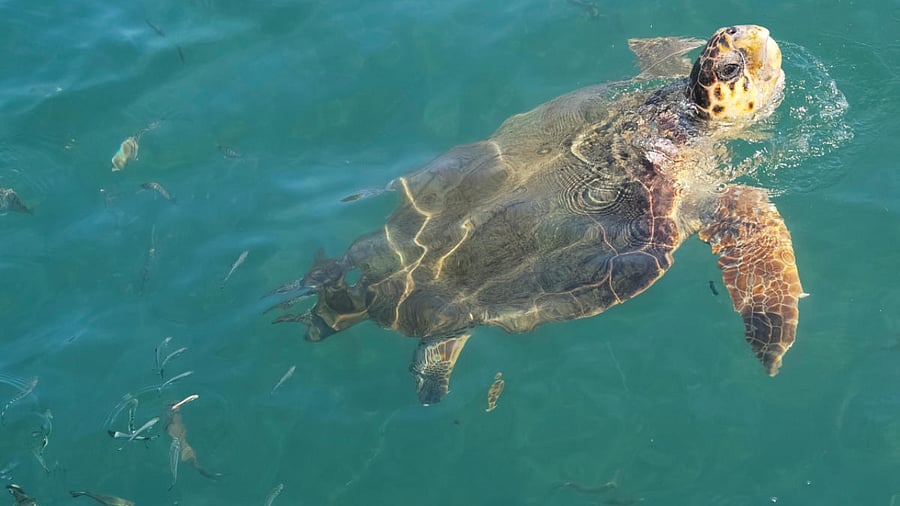
A sea turtle.
Credit: Reuters Photo
Spoorthy Raman
Cuddling a palm-sized tortoise, which shyly withdraws its head into its patterned shell, seems so appealing that it has spurred a growing interest among people to own it as a pet. For some, its meat—especially the soft gelatinous tissue on the lower shell called calipee—is appetising. The result: Tortoises and turtles are now the most trafficked animals in the multi-billion-dollar international wildlife trade.
The exploitation of these reptiles is so severe in Asia that over half of the 90-odd species are classified as endangered or critically endangered—a phenomenon now known as the Asian turtle crisis.
A recent study by researchers at the Wildlife Conservation Society - India (WCS-India) has unearthed the treacherous wildlife trafficking network in the trade of freshwater tortoises and turtles in India. Published in the journal Oryx, it finds that tortoises and hard-shelled turtles were trafficked primarily for pet trade, while soft-shelled turtles were in demand for their meat. The findings indicate that major cities nationwide serve as exporting, importing or transit hubs for the illegal trade network involving these reptiles.
“For tortoises and freshwater turtles especially, we realised that illegal trade operations varied across products or types of demand,” says Ramya Roopa Sengottuvel, who led the study. “We wanted to explore this question through our data using pet and meat-based trafficking as case studies.”
The researchers relied on a database of nearly 300 media reports published between 2013 and 2019, covering details on poaching incidents and the illegal trade of almost 73,000 individual tortoises and freshwater turtles. They extracted information on the species, the traded body parts, the number of tortoises and the route and built a network of possible trafficking routes.
“Considering the sheer number of turtles being confiscated every year, it shows how dire the situation is,” says wildlife biologist Sneha Dharwardkar, who has studied freshwater turtles and tortoises in India but was not involved in the study. “A lot of trade is demand-driven.”
Thriving hubs of turtle trade
The analysis revealed that the network was highly organised for tortoises and hard-shelled turtles and involved transnational criminal gangs. Chennai acted as a central node for the export and import of these reptiles, while Mumbai, Kolkata, Bengaluru, Agra and Anantapur emerged as major outgoing hubs. Most of India’s tortoises and hard-shelled freshwater turtles were exported to Kuala Lumpur, Bangkok and parts of Bangladesh. Interestingly, the traffickers mostly used air transport, which typically has stricter entry and exit checks.
The soft-shelled turtles were mostly trafficked within India, primarily through road and rail, from districts in Uttar Pradesh, such as Varanasi, Jaunpur, Pratapgarh and Sultanpur, which lie on the Gangetic Plain. They were mostly sent to Kolkata, North 24 Parganas and other districts in West Bengal, and then to Bangladesh—a route that human and drug traffickers also follow.
Species at most risk
Half of India’s 30 tortoise and freshwater turtle species are documented in illegal trade. Among them, all but four are protected under the Wildlife Act of 1972, which prohibits the hunting and trading of these species. Yet, trafficking thrives.
The most prominently-traded species for pet trade is the Indian star tortoise (Geochelone elegans), which is classified as vulnerable by the International Union for Conservation of Nature. The tortoise is so heavily exploited and hunted that a 2023 study found a drastic decline in its genetic diversity. The Indian flapshell turtle (Lissemys punctata), a vulnerable species, and the endangered Indian softshell turtle (Nilssonia gangetica) are the most traded soft-shelled turtles for their meat.
However, the researchers found other species too. “The appearance of other species in the trade, including the critically endangered red-crowned roofed turtle and three-striped roofed turtle for the pet trade, and the Indian narrow-headed softshell turtle for their calipee and meat is also of great concern,” says co-author Uttara Mendiratta from WCS-India.
From her experience, Dharwadkar adds spotted pond turtles and narrow-headed softshell turtles to this list, as they are “routinely confiscated, indicating serious trade in these species.”
Challenges for conservation
Tortoises and freshwater turtles chomp on decaying matter and help maintain water quality in rivers and lakes. Their conservation has unique challenges: they live very long and take years to mature sexually and reproduce. Most of their eggs and hatchlings die. “Therefore, they are in danger of being extirpated when adults are over-harvested,” says Sengottuvel.
Unprecedented hunting of these reptiles over the years has begun to show some alarming trends. “Indian softshell turtles were very frequently seized previously,” says Mendiratta. “Nowadays, most seizures largely comprise of the much smaller and [more] widespread Indian flapshell turtle.” Due to hunting and illegal trade, older softshell turtles have already become rare in the Gangetic plain.
While the illegal trafficking of freshwater turtles and tortoises decimates native Indian species, turtles imported into the country to satiate the pet trade demand often end up as invasive species in India’s lakes and rivers. For instance, the red-eared slider—a native of the USA but found even in lakes of Bengaluru—is the most popular pet turtle globally that has been heavily traded for years. It is included in the list of the 100 most invasive species worldwide.
The researchers say their findings call for stricter surveillance in key transport hubs identified and better collaborations between regulating agencies.
They also suggest authorities must investigate suspected infrastructure facilities along the transport hubs—warehouses
and hatcheries that store illegally hunted turtles and tortoises. “By understanding the various locations and pathways of trade, we hope that there is more clarity on where interventions should be prioritised,” says Sengottuvel.
The study, based purely on media reports, is the first to analyse the trafficking network of these reptiles in India.